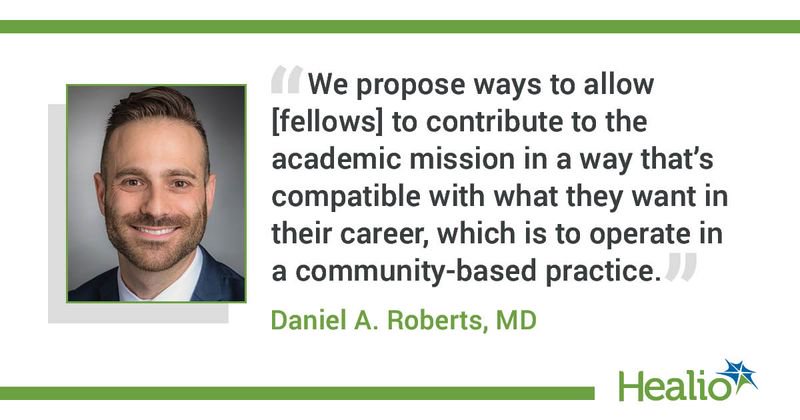Hem/onc fellowship training model offers community-oriented option
Community oncology practices have become an increasingly important setting for cancer care delivery in the United States.
To reflect this evolving oncology landscape, researchers at Dana-Farber Cancer Institute, Beth Israel Deaconess Medical Center and Harvard Medical School have proposed a first-ever training blueprint for oncologists planning careers in a community or academic-community environment. The proposal would also help promote use of academic-community hybrid (ACH) models, in which large, academic cancer centers establish and work with networks of smaller community providers.

The proposed fellowship model is outlined in a paper published in JCO Oncology Practice.
“When folks apply for hem/onc fellowships, they are internal medicine residents and the application focuses largely on academic gravitas,” first author Daniel A. Roberts, MD, associate medical director for quality at Dana-Farber Cancer Institute Network, told Healio. “Most of these fellowships are structured in a way that’s meant to produce traditional academicians. For the folks who want to contribute to the academic mission but don’t necessarily want to focus on applying for grants and funding, there is no formal structure.”
Roberts spoke with Healio about the community oncology-focused fellowship track his team proposed and the value of offering such a program to future oncology trainees.
Healio: What inspired you to develop this blueprint for a community-focused track for oncology fellows?
Roberts: I figured out probably halfway through my first year that I definitely wanted to do community practice, or at least have that be the basis of my training. There was no track for me — there was no one who was saying, “OK, this is what you should do to be as prepared as possible.” So, I made my own track at Beth Israel Deaconess, which is where I trained. I was the first fellow to go to their flagship center, the BID Needham Cancer Center. I did the bulk of my last 2 years of clinical training there. A lot of folks have done that now — it’s almost a set track at BID Needham; they have about five fellows at a time doing this. When I was a fellow, though, I was on my own. I sought out opportunities to better prepare myself for the issues I expected to be relevant to my practice. I did a lot of quality improvement work. They have a robust program at Beth Israel Deaconess. I reached out to the Community Oncology Alliance. I found other societies and made some contacts. When I finished my fellowship, I presented my senior talk, which ended up being the nuts and bolts of the paper. What I wanted was what a lot of people want, but there is no clear formalized process for this. The ideas in our paper have been suggested before; we are not the first people who thought of them.
Healio: What does your paper propose in terms of a community-oriented option for hematology/oncology fellows?
Roberts: This is not a separate fellowship program but would be a specific track or path once someone gets into a hematology/oncology fellowship program. In the paper, we lay out the existing model, which varies throughout the country. Some of the programs are probably doing this type of thing already, but to my knowledge it has not been formalized.
Typically, there is a boilerplate formula to most fellowships: the first year is heavily clinical, a lot of outpatient clinical work — maybe some inpatient work — and then you’re pushed to do research for the last 2 years and publish and figure out your niche. Our concept is to provide options to all the fellows who don’t necessarily want to do research in the traditional sense. We propose ways to allow them to contribute to the academic mission in a way that’s compatible with what they want in their career, which is to operate in a community-based practice. Admittedly, community-based practice interacts in a highly complex environment with academics. We’re not suggesting separating academics from the community path. We’re acknowledging that they’re intertwined. Very few people are going to go right into private practice and be expected to treat patients without a basis of understanding about the cancer care delivery system. This concept is meant to take the fellows who want a community-based practice and focus their extracurricular time on concepts like quality and patient safety, business operations, community-based clinical trials and health equity, in an effort to better prepare them for when they end up having careers at a community-based practice.
Healio: Is there anything else you think would be important to mention on this topic?
Roberts: I would clarify that this is conceptual right now and not meant to supplant the existing structure. It is meant to supplement this structure. The data about what fellows do after their fellowships shows that about half of them go into community practice, but we’re not really training them to do that. The traditional model trains them to be academic researchers, which is great for folks who end up doing that. However, it is suboptimal for the fellows who don’t want to pursue that path. Lastly, I want to reiterate that many fellowships throughout the country are probably doing pieces of this based on their own community needs and that of their fellows. However, we need to formally recognize this as an important track and effort in training the next generation of hematologists/oncologists.
For more information:
Daniel A. Roberts, MD, can be reached at Dana-Farber Brigham Cancer Center -Foxborough, 22 Patriot Place, Foxborough, MA 02035; email: daniel_roberts@dfci.harvard.edu.
